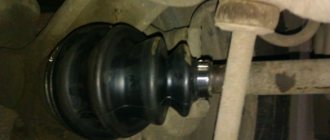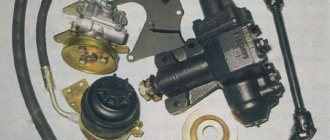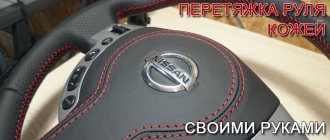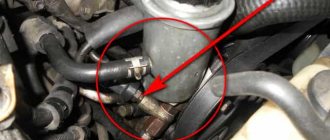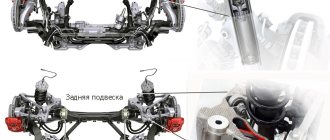Home > Useful information > For what reasons can the power steering fail? Most modern cars today are equipped with such a useful mechanism as power steering. The main principle of operation of this device is to ensure comfortable maneuvering of the car at low speeds without the use of serious physical effort, as would be required, for example, on the old Volga. But with all the advantages of power steering, it also has one significant drawback, namely, like all other elements of the car, it can be subject to malfunctions. We will talk about them in this article.
Possible malfunctions of the power steering
Power steering is considered an important element of steering control. Malfunctions of the power steering can lead to accidents on the road, because the control system is one of the most important systems of the entire car. In this article I will tell you how to diagnose power steering faults and describe how to fix them.
The content of the article
Signs of trouble
Signs of a faulty power steering include many factors. Among them, I will try to identify the most important ones that are often encountered. There are two criteria according to which faults can be divided: faults of the pump and power steering gearbox.
- Let's start with external problems. If you hold the steering wheel and feel shocks, this indicates that the drive belt is loose. If you need to apply force to turn right or left, then I advise you to pay attention to the drive belt and inspect the filling tank (fluid level and whether there is any dirt). Perhaps the reason is that the engine idle speed is low. If the power steering has recently been replaced, check to see if the system has been aired out. Returning to the situation with turns, when it is difficult to turn the steering wheel in one direction, it is worth looking at the oil pump. Perhaps there is a problem hidden there. Vibration is felt when the tires are in poor condition.
- If it is difficult or very easy to turn the steering wheel, you need to check the electronic equipment and speedometer. Do not forget about the level of working fluid in the tank - if it is not enough, the power steering system may stop working.
- If the pump pulley in the machine unscrews without unnecessary force, then the cause of the malfunction lies in a defect in the shafts on which the pulley is incorrectly placed. For example, I heard a whistling sound - this indicated that the steering wheel joints were loosened. It is possible that the power steering hoses are not in full contact with other system components.
- If you hear noise in the steering wheel, then this is a very bad sign, since the power steering tubes are not securely fastened to the body, or the tie rod ends are installed incorrectly and the fastening itself is loose.
- When, while driving, you feel the labor-intensive return of the wheels to a smooth movement forward (after) turns, then the reason lies in the loose fit of the steering wheel with the turn switch, inaccurate alignment of the flow control valve, weakening of the steering rods and ball joints.
- When the steering wheel turns, this indicates that the power steering is operating with insufficient pressure in the pump, or its valve that controls the flow is jammed. When it is impossible to drive a car, and I had such a case, I checked the control system for air, then the wheels for wear or damage to the bearings. But, as it turned out, the problem was hidden in the weakening of the steering rods and ball joints.
- If it is difficult to park the car (the driver's inability is not considered here), then the reason may be a dysfunction of the power steering pump flow control valve or insufficient pump pressure.
Troubleshooting and operating tips
So, when we have found out why the power steering does not work, we can begin repairing and troubleshooting. You will have to work on this yourself if the dysfunctions are minor, and if not, then it is better to turn to specialists at a car service center for help.
What can you do on your own? Adjust or replace the drive belt, add working fluid or replace the entire filter if it is dirty and there is not enough fluid. A few words about the fluid - you shouldn’t change it often. If you are already doing this, then you need to drain the previous oil and fill in new one. You need to be careful about airing the system.
Since I often encountered fluid leaks, the principle of operation in such a situation is somewhat different. Oil leaks occur through bearings and shafts, so it is important to inspect the entire power steering system regularly for timely detection of leaks from fittings and pipelines.
A car service center will help you repair or replace your hydraulic booster. As for the repair of the power steering pump, namely it is considered in the first place when the power steering malfunctions, then first you need to remove and disassemble it, then thoroughly clean it of dirt and inspect all the parts. There may be a hole on the inner wall of the housing in the form of a step; you can get rid of it using a drill attachment.
If the bearing is worn out or the oil seal is outdated, then they need to be replaced. How to attach the new bearing back? I’m sharing my experience: I make a groove on the outside of the turner, then I drill holes in the wall of the pump, insert a bearing into it and secure it with bolts, through the holes and saw them off.
Most of the issues come down to changing parts; if everything is done correctly, the hydraulic booster will work in the future and will please you with its serviceability in high-quality and easy turns and driving.
Let's move on to operating tips so that the power steering lasts a long time and you don't even wonder about its location. The first thing I advise you to pay attention to is regularly comparing the steering effort when turning with the engine off. If you feel the difference, then everything is fine.
You should always monitor the level of the working fluid, avoid the minimum level, and inspect the lines and connections to prevent oil leakage through the bearings.
The second is to check the tension of the drive belt; if it is too tight, the pump will soon have to be repaired; if it is loose, it will wear out quickly. Once a year, I recommend changing the filter; do not hold the steering wheel in the extreme position for more than a minute, as in this case the oil may boil.
Third, I urge you not to drive a car with a non-working power steering, then you can completely destroy the steering as a system. And, of course, at the first signs of dysfunction, seek help from a service station.
Video “Power steering malfunctions”
After watching the recording, you will learn what to do if the power steering pump in your car begins to howl. The video also shows how the power steering repair process occurs and what tools are needed for this.
mineavto.ru
How does a faulty or worn hydraulic booster behave?
In most cases, complete or partial damage to the hydraulic booster system is accompanied by loss of vehicle controllability. If the amplifier function has disappeared completely, the steering wheel is difficult to turn in both directions, it is necessary to carry out a detailed and thorough check of the device. It is possible that the rubber seal of the moving element inside the system is damaged. Also, a violation of the power steering function can manifest itself in the form of insufficient gain at idle. If the working fluid begins to foam or the power steering operation is accompanied by excessive sounds, it is also necessary to diagnose the system.
There are a huge number of malfunctions of the hydraulic booster, just like the reasons. There is no need to list all possible malfunctions for which it is necessary to subject the amplifier to diagnostics. The above symptoms are a clear need to check the condition of the amplification system components.
To maintain your own safety and increase the service life of the power steering, check and maintain the system in a timely manner. Remember that the quality of the working fluid used largely affects the level of wear of working elements. Check and replace the used hydraulic booster mixture in a timely manner, this way you will prevent the need for large-scale repairs. If characteristic signs of a malfunction occur, promptly begin to identify and eliminate the causes. As a rule, power steering diagnostics are successfully performed by motorists. If serious problems occur, it is better to leave power steering restoration in the hands of professionals. Successful diagnostic results and speedy repair!
Basic steering faults
Faulty steering poses a danger not only to the driver, but also to other road users. Often, it is loss of control of the car that causes fatal accidents.
The vehicle driver must pay special attention to steering diagnostics to ensure timely detection of faults. If any are found, they must be eliminated as soon as possible.
Basic steering faults
There are a number of signs indicating that urgent steering diagnostics are needed. Their appearance is a signal for the car driver to seek help from specialists.
The following main steering faults can be identified:
Steering wheel play
This kind of malfunction occurs in the following cases:
- increased clearance in steering rod joints
- loosening the nuts in the ball studs
- wear of rubber-metal traction elements
- wear of cardan joints
Noise when turning the steering wheel
Possible reasons are as follows:
- wear of steering rod joints
- loosening of the steering gear fasteners
- loosening of ball pin fasteners
Stiff steering wheel rotation
Additional effort is required to turn the steering wheel.
The following reasons for this malfunction can be identified:
- wear of the main elements of steering rods
- support rail bushing worn
- low car tire pressure
- Worn upper strut bearing
- wear of elements of the telescopic strut of the front suspension
Violation of machine stability
The following main causes of malfunction are identified:
- car wheel alignment angles are incorrect
- reduction in the fastening capacity of the tie rod pin nuts
- increasing the clearance in the front wheel bearings.
If steering malfunctions are detected, you must immediately take measures to eliminate them. Traveling in a car with such serious defects is very dangerous to human life and health.
Thank you for your attention, good luck on your journey.
www.avtogide.ru
How to choose correctly
You can find a new pump using the vehicle's VIN code. This way you can quickly find the original and check the compatibility of some analogues. You will also not experience the problem of an installed pump, which has similar dimensions to the old one, but creates too much or too little pressure in the system. The problematic spare part will either work incorrectly or break too early.
To select analogues bypassing the transport code, you need to know the code of the old pump . If this is not a suitable option, you should look into electronic catalogs. They conveniently sort spare parts by car brands, models, years of manufacture and a number of technical data.
The first signs of a steering problem
Every motorist should know about the first signs of steering failure. After all, a new driving season has arrived, which means we will drive more, more often and further, and speeds will increase noticeably. Therefore, now the good technical condition of the car is especially important, first of all, this concerns the steering, because in case of some malfunctions, the traffic rules prohibit further operation of the vehicle.
Let's figure out how the first signs of a malfunction manifest themselves, what you can do to continue driving, and what shortens the life of the steering. The most common are characteristic knocks that occur when driving over even small irregularities. In especially advanced cases, a beating on the steering wheel even begins to be felt. Most often, this is a sign that the steering ends and steering rack have failed. According to mechanics, it is the Nissan steering rack that is the main problem with cars of this brand.
A deteriorated steering rod ball joint makes itself felt by increased play or idling of the steering wheel. This means that to turn the wheels you need to turn it at a much larger angle. In other words, with a large backlash, you will not only not undergo scheduled maintenance, but also do not have the right to go on the road, because A poorly driven car is a doubly dangerous source.
The power steering may also fail. Today it is hydraulic and electric. But in both cases, the malfunction is manifested by difficult rotation of the steering wheel. Other signs are leaks of working fluid, extraneous noise and a characteristic whistle.
The steering rarely fails instantly, and this is its advantage. Therefore, if you notice a change in the behavior of the car, do not put the problem off for a long time, visit the service center. Otherwise, one malfunction may lead to the next more serious one. And don’t skimp on consumables – rubber bushings and boots, they are not expensive. Controls must operate in a sealed environment to ensure longevity.
And now about the main cause of all steering malfunctions - about you and me. Modern engines are quite powerful and heavy, plus, add summer speeds, and crossing any road irregularities, especially speed bumps, is a shock that is transmitted to all steering elements. Therefore, obstacles should be overcome by rolling smoothly. There is another way to comfortably overcome a speed bump. You will learn about it from this article.
Remember that wheel alignment greatly affects tire wear, and tires are very expensive today. But without proper steering, it cannot be adjusted.
And finally, I suggest watching a video about steering malfunctions
Similar articles:
You can skip reading the entries and leave a comment. Posting links is prohibited.
drivee.ru
What indicates problems with the pump
A faulty pump affects the entire steering system. It will be very difficult for you to control the steering wheel, turning which will require significant effort. This is the first thing you can't help but pay attention to. But having studied the system, you can find the following:
- The hydraulic fluid level is very low. This can be determined by the expansion tank. The hydraulics begin to work in such a way that scuffs and abrasions appear on the metal;
- Poor oil condition. It should not be dark, burnt or foamy. Please note: small foreign inclusions indicate the operating characteristics of the pump. For example, small chips indicate abrasion of parts. Dirty oil should be changed as soon as possible;
- air in the power steering system . It gets there either when there is a lack of oil or when the seals are damaged. Pay attention to the rubber parts too;
- Low drive belt tension. Everything is clear here: there is no torque transmission, there is no working pump;
- The pump “howls” due to the displacement of the mesh in the power steering fluid reservoir. The problem is not the most common, but if the pressure in the system is constantly very high, the mesh may come out of the guide skids. This problem can be solved without the help of a specialist, but the effect will not be long-lasting.
If the power steering starts to bother you, it is better to go to a service station for help. And if the pump completely fails and driving the car is too difficult, it is better to call for help. A completely faulty pump is not repaired, but simply replaced with a new one.
Signs of a faulty steering rack: causes and symptoms
The steering rack is the mechanism responsible for converting the rotation of the steering wheel into turning the wheels. It takes on heavy loads when driving on uneven roads. Therefore, regardless of the brand of the car, it often requires repair or replacement. Signs of a faulty steering rack will indicate that the mechanism is broken.
What is a steering rack
The wheel turning mechanism consists of two parts: rack and pinion. Rotating the steering wheel triggers the movement of the gear, which moves the rack left or right. As a result, the wheels turn in the desired direction.
Metal parts of the mechanism can be difficult to turn, which is why modern cars are equipped with amplifiers. There are two types of amplifier - hydraulic and electric. They make turning the steering wheel smooth and easy. The power steering or electric power steering is mounted directly on the rack.
Power steering improves driving safety by dampening vibrations and knocks from the road. The driver feels more confident behind the wheel. On the other hand, this slightly deteriorates the car's handling.
Safety on the road largely depends on the steering. In case of any malfunctions, maneuverability deteriorates, as a result, the driver cannot react to the road situation. Therefore, it is important to maintain the steering in working condition and pay attention to all symptoms of breakdowns.
Symptoms of breakdowns
The following symptoms will tell you that the steering rack is broken:
- the steering wheel turns hard;
- oil leaks from the steering device;
- while driving over bumps, knocking or humming is heard from the front of the car;
- a hum is heard when turning the steering wheel;
- the steering wheel sticks.
If you notice one or more symptoms, go to a car service for diagnosis and repair. The sooner you contact specialists, the less money you will spend on repairs.
How to determine whether a steering rack is faulty
All steering rack malfunctions can be divided into three types - knocking, humming and leaking. Leakage is typical only for devices with hydraulic booster, since the power steering operates without oil, which means it cannot leak.
There are two types of knocks: superficial and internal. The first ones appear from the tie rod end. Through a torn boot, street dirt gets into the mechanism, the tip fails and begins to knock. You can change it yourself by looking at the steps of the process in the car manual.
An internal knock indicates that the pistons and guide rails have failed. It is very difficult to independently determine the cause, since you need to disassemble the entire mechanism.
Oil leakage occurs when rubber seals fail. The pump pumps working fluid into the cylinder, the pressure increases and the mechanism begins to move. If the seals do not perform their function, the pressure does not reach the required value. The mechanism does not work as it should, and there is play in the steering wheel.
The leak can be easily seen on the asphalt under the car. In addition, the “Add power steering fluid” light on the dashboard is constantly on. But after topping up the situation does not improve. Oil has to be added every day. This is a reason to change the seals.
The hum occurs when the power steering pump or power steering motor fails. They do not cope with their function, and it becomes more difficult for the driver to turn the steering wheel.
Causes of steering rack malfunction
When driving carefully and using the car correctly, the only cause of a steering rack malfunction is its wear and tear.
For each part, the manufacturer sets its own service life; for a rack it is usually 100 thousand km. The timing may vary for each model. Most often, this part is changed by those who drive on bad roads. Getting into a hole wears out the suspension and steering. If you don’t slow down for bumps and potholes, you can become a regular visitor to car services. Also, the rack does not like sudden starts. It is not recommended to drive away suddenly if the wheels are turned to the side.
Another common cause of problems is a boot break. This delicate part protects important mechanisms and therefore requires constant attention. Even cracks on the boot are a reason to replace them. Moisture, dust or dirt that gets inside the device can cause serious damage.
Mechanism repair
Since the steering rack has a complex structure, auto repairmen rarely disassemble it and repair it. It is much easier to buy an assembled spare part and install it on the car.
Today on the market there are original auto parts and cheaper analogues. Car manufacturers recommend installing only original parts, as they fit perfectly into all car systems. But the experience of car enthusiasts says that similar spare parts also last a long time. The main thing is to choose a good manufacturer. This can be done by reading reviews on the Internet or asking advice from an experienced car enthusiast.
Do not forget to periodically change consumables - bushings, oil seals, boots. Periodically inspect the bottom of the car; if there are cracks or leaks, immediately buy a repair kit. This will extend the life of the entire device.
A thrifty and careful driver may not even think about the steering rack throughout the entire period of owning the car. Therefore, it is worth following simple operating rules: avoid potholes, slow down before bumps, and if you have the first symptoms of breakdowns, immediately contact a car service center. Then the device will serve you for a long time.
automorum.ru
Time to replace or repair the power steering pump
It is quite difficult to say when a pump requires replacement. In most cases, it is “reanimated” by replacing pipes and seals, i.e. consumables. The drive belt may also require replacement. Complete replacement is only required if the metal parts are worn out. As a rule, they are erased. The system is extremely durable and resistant to mechanical damage, so the appearance of cracks most likely indicates that a fake pump made of low-quality metal was purchased. Although there are also interesting cases that service station workers can tell you.
As a rule, the power steering pump breaks down and requires complete replacement for three reasons:
- Wear due to the use of poor hydraulic fluid;
- A wedge of parts has appeared due to poor processing of the rotor metal;
- The action of time.
If you operate your car correctly and drive calmly, you may not have to deal with replacing the pump at all. The main problem of the hydraulic booster is precisely that it does not tolerate extreme driving well. However, situations on the road may be different. are not delighted with hydraulic power steering - it is very practical for driving at low and medium speeds on smooth city roads, but is not very suitable for aggressive driving and behaves poorly in emergency cases, such as a possible accident.
Play in the steering: how to fix it yourself
The importance of the steering system of a car is not worth mentioning once again, since it is already clear to everyone that it plays a key role in driving safety. That is why you should not neglect regular inspection and repair of all parts of this system, because frequent use leads to wear and tear of even the most reliable components and assemblies. The most common symptom of a malfunction is the phenomenon of steering wheel play. Any motorist who is more or less literate and knowledgeable about traffic rules should be familiar with this term in order to be able, if desired, to diagnose and fix the problem in a timely manner.
The content of the article
What is backlash
In order to understand how the total play in the steering works, you need to understand a little about the design of the steering system. From a technical point of view, it can be described something like this: in the transmission of steering rods there is a rod that is not fixed tightly, with a gap of 1-2 millimeters. If it were not for this distance, then all the parts involved would wear out much faster, as a result of strong friction. The gap allows you to hold the hook without coming into contact with the walls of the gear teeth - this is where the backlash arises.
From the driver's perspective, play is defined as the free movement of the steering wheel necessary to obtain the response of the element of the system that you control (in our case, the front wheels). Simply put, this is the distance the steering wheel travels before the car makes a certain maneuver. This phenomenon cannot be called negative, since minimal play is present in the control of any car and increases in proportion to the size of the vehicle.
However, after a long period of operation, the backlash increases to a dangerous level, when the car stops listening and responds late to the driver’s “commands”.
If you do not react in time and do not carry out an inspection, at best you will face expensive repairs, at worst - according to the traffic rules, your car becomes a potential source of danger on the road.
Causes of backlash
You need to look for the cause of the play, of course, in the design of the steering system:
- To begin with, check the condition of the steering rods, as well as the tips. The latter quite often fail, and this can cause too much free play in the steering wheel.
- In addition, the source of the problem can be a collapsed or almost collapsed wheel bearing.
- If the chassis of your car has recently been repaired, then the resulting play may be a consequence of this. For example, very often mechanics forget to properly tighten the central nut of the hub bearing, which does not have the best effect on the operation of the steering system.
- The cause may also be a failure of the upper or lower ball joint, or an overtightened steering rack.
- Sometimes play appears when the hydraulic oil needs to be changed - this simple procedure can eliminate the excess free play.
In general, backlash is almost always provoked by some kind of malfunction in the steering wheel-rack-traction-wheel chain. In order to identify the cause, you need to go through each link, carefully check the details and identify where and what was not tightened - since it is precisely this element that is stopping the work of the control. But in order not to confuse the backlash with any other faults, you need to study its practical symptoms.
Signs
If the car’s chassis becomes less and less sensitive to your influences, then it’s time to analyze the problems that have arisen in the control. The maximum permissible free play of the steering wheel is 30 millimeters, or 10 degrees, according to traffic regulations. Any deviations from the norm are considered malfunctions.
In order to determine whether the backlash fits within this parameter, you need to do a small check:
- First, set the engine to idle and set the front wheels in such a position that they are parallel to the longitudinal axis of the car. The hydraulic booster must also work at the same time.
- Then you need to slightly turn the steering wheel in different directions and record the moment when the front tires begin to move. The entire distance that the steering wheel travels “to” is free play, that is, backlash.
- For an accurate check, you can get hold of a play meter - this is a special device that is used to control the total play in the steering of a car. For example, the mechanical model of the play meter K 524 M can be used both in a home garage and in professional auto repair shops. The 524 playmeter will help you determine free play in just three minutes - including installation and removal of the device. This check is the simplest and most convenient option.
Although in fact it doesn’t matter what exactly helped you diagnose the problem - the 524 play meter, some other model of this device, or simple measuring tools. If the problem is identified, you need to fix it.
How to remove
In order to adjust the steering, you will need a few simple tools that will allow you to adjust the mounts.
If the K 524 M play meter shows an undesirable result, you should try adjusting the universal joint reinforcement screws. These elements are located on the steering shaft. To do this, we find the hinge adjustment screw and set the acceptable value. Then the check is repeated, and if the free play is still exceeded, then the reason is different.
If the readings on the backlash meter are too high, it is also recommended to adjust the steering rod joints. But this will be more difficult to do, since you will need a lift or a room with an inspection hole. Most likely, you will find that the hinges are “broken,” which means their fastenings need tightening. You can also tighten the tie rods.
Sometimes the condition of the parts leaves no other options but to completely disassemble the steering mechanism and replace worn elements. In this case, it is better to turn to the services of a professional auto repair shop so as not to damage the system due to inexperience.
Video “Eliminating play in the steering mechanism”
Here they will help us deal with the play in the steering mechanism of the Renault Logan car
mineavto.ru
What determines the price?
You can save on literally everything: the quality of metal processing, hydraulic fluid, seals, pulleys, etc. Often a low-quality pump is confused with an outright counterfeit. We don't know whether this will make you happy or disappointed. If desired, you can make a pump of any quality and for almost any money. The production of the worst pumps is concentrated in China, although individual enterprises may be located in the Czech Republic and Poland. Poor quality power steering components fail very early and can cause breakdown of adjacent components. So if you want to buy a quality spare part, pay attention to the brand’s reputation (we have listed those who are trustworthy above) and the price. A good pump cannot cost little. The country of origin does not decide anything today, only demand and a serious attitude towards how to satisfy the demand.
In theory, it is possible to purchase a used power steering pump. Although its metal part hardly wears out, there is still a risk. The metal resource is limited - this is the first thing. Second: you will probably have to clean the product, replace the seals and the pulley. As a result, you will receive a spare part that will last half as long as a new one. But before that it was necessary to spend money on getting the pump in order. The savings will not be doubtful only if you purchase a new pump that has been used correctly and not for too long.
Steering rack malfunctions: how to determine signs of wear
1 Types of steering racks
Depending on the scope of application, manufacturer and category of the vehicle, there are three types of these devices:
- Mechanical. The driver's force when turning the steering wheel is transmitted directly to the steering (usually front) wheels using a system of gears, the so-called “worm” gear. This type of mechanism is a classic in the automotive industry, and is currently practically not used due to minimal operating comfort for the driver of the vehicle.
- Hydraulic. The most common type of racks in vehicle control systems. It has become widespread due to its relative ease of maintenance and impressive efficiency. Initially, such hydraulic racks found particularly widespread use in the design of heavy construction and agricultural equipment and on trucks. It is worth noting that with this type of control design, in addition to the rack itself, the adjacent power steering pump (power steering) plays a major role.
- Electromechanical. A relatively new type of control amplifier design. Electric motors are used to increase the load on the wheels from the steering column. Moreover, they can be located on the steering column, rack or directly on the shafts connecting the unit to the wheels. This type of amplifier is the most “capricious” and often fails in our climate.
Important! There are cars on the market with combined power steering. For example, some TOYOTA Vista models are equipped with steering mechanisms on all four wheels. Moreover, the front wheels are controlled using hydraulic amplifiers, and the rear wheels are controlled using electric motors.
Below we will consider the main reasons that can lead to a malfunction of the steering rack of a vehicle, as well as signs by which it can be determined that the moment has come when, without delay, it is necessary to diagnose this vital mechanism of the car.
2 Causes of malfunctions
- “Aggressive” driving on off-road or roads with poor quality surfaces. This type of movement involves constantly getting the front wheels into potholes, holes, and ditches. In this case, there is a colossal load on the tie rod ends and, as a consequence, on the rod itself. The greatest load occurs when the wheel hits an uneven road when it is in turning mode.
- Low-quality components, namely oil seals, silent blocks attached to the body, steering shaft crosspiece, power cylinder.
- Poor quality hydraulic fluid in the power steering pump or air entering the power steering system.
- Damp contacts of terminals or brushes of electric motors. In the case of electromechanical racks, this situation is not uncommon when the vehicle is operated in conditions of high humidity or when there is insufficient water protection at the electrical wiring connection points.
For such a unit as the steering rack of a car, there are a number of signs of malfunction that are inherent in all types of this unit. At the same time, the hydraulic and electromechanical types have some features due to their more complex structure and operating features.
5 Signs of a faulty electromechanical rack
- The angle of rotation of the wheels does not correspond to the rotation of the steering wheel. This defect manifests itself in the following: when the steering wheel is turned completely in any direction, the wheels only slightly change the angle of rotation or generally remain in their original position. This indicates that the electric steering is not working. The reason, as a rule, is dampness and oxidation of the terminals connecting the wiring and electric drives.
- Systematic blown power steering fuses. This fact indicates that a short circuit periodically occurs in the power supply circuit of the power steering motors. The reason is wear on the motor brushes or water getting on its stator.
If the above signs of malfunctions are detected during the operation of the vehicle, it is worth taking the time to diagnose the control system.
tuningkod.ru
How does a power steering pump work?
The most common pump design is a vane pump, also called a vane or vane pump. The essence of its work comes down to the fact that the retractable blades cover some internal sectors of the structure. Oil enters them, which then moves to the injection area and is discharged through the outlet pipe . At the same time, pressure builds up in sectors filled with liquid.
A small expansion tank is needed to compensate for excess pressure. A relief valve is used to relieve pressure. The tanks are either located next to the pump or installed separately from it in the engine compartment. Hydraulic boosters installed on a car can have one or two circuits. Single-circuit ones ensure the operation of the rack with an amplifier, and double-circuit ones also “drive” fluid through the hydraulic suspension. The second type is represented by a rather complex hydraulic system, the price of which is quite high.
Power steering malfunctions: causes, main symptoms
Power steering (power steering) is installed on modern passenger cars to simplify the process of driving a vehicle. It makes it easier to turn the steering wheel of the car when performing maneuvers at low speed, and provides shock mitigation when hitting obstacles and uneven road surfaces. Due to this, the driver gets much less tired when driving within the city and when making long trips. Power steering faults should be repaired as soon as they are discovered, as they can cause serious traffic accidents.
1 What does an ordinary driver need to know about the design of a hydraulic booster?
Power steering is a closed hydraulic system, which was previously installed exclusively on trucks and special equipment. Now it is also installed on passenger cars. It consists of the following elements:
- Pump.
- Pressure distributor.
- Control spool.
- Power cylinder.
- Tank.
- Pipelines.
The pump creates a certain pressure and circulates the working fluid (oil) in the hydraulic booster. It can be bladed (rotor) or gear-type. Modern passenger cars use mechanisms of the first type.
The pump sets the working oil pressure and directs it to the rotary spool valve. The latter is an intermediate element between the gear and the column shaft. It analyzes the position of the steering wheel and distributes the fluid flow in the right directions. The control valve is responsible for this operation, which closes and opens the required channels of the system.
The power steering actuator is the power cylinder. It can be combined - built into the steering mechanism, or conventional (installed between the drive elements and the car body). The first option is more common. In a combined hydraulic power steering system, the steering rack acts as a piston.
Connecting pipelines are necessary for the normal movement of the working composition through the mechanism. Low pressure hoses are used to supply fluid from the reservoir to the pump. The high pressure pipeline connects the hydraulic cylinder and the switchgear into one system.
The tank is an ordinary reservoir. It has a plug with a dipstick and a filter. The tank stores a supply of oil necessary for power steering operation.
2 System malfunctions, reasons for their occurrence and tips for troubleshooting problems
Power steering is a highly reliable mechanism. When operating the vehicle, it does not require special maintenance. It is allowed to continue driving the car even in cases where the power steering pump fails. But in such a situation, the driver will have to make more effort to turn the steering wheel.
Complete system failure occurs when the drive belt connected to the pump breaks. Such situations arise when the machine is used for a long time without checking the power steering components. If there is a reverse shock (kickback) when turning the steering wheel, this is a sign that the drive belt is poorly tensioned or very worn. The problem is solved by replacing or adjusting it.
Difficulties in turning wheels (the need to apply great effort) arise for various reasons. Such cases are due to:
- The presence of air in the hydraulic booster. The solution to the problem is simple. Air should be removed from the system and the condition of all sealing elements should be checked for leaks.
- Low pump pressure. It should be replaced or repaired.
- The oil tank filter is dirty. A new device is being installed to remove foreign particles in the working fluid.
- Low idle speed of the power unit. Engine tuning required.
- Insufficient oil level. It is necessary to add the working composition to the tank.
Malfunctions of the power steering also manifest themselves in other ways. System repair is required if:
- When the power steering is operating, a characteristic noise is heard. It signals damage to pipelines or pump failure. Worn hoses should be replaced. If they are in good condition, you need to check the power steering pump for functionality.
- When the steering wheel is in the extreme position, a whistle is heard. The reason for this phenomenon is the release of oil through the safety valve. This element is checked and replaced if necessary.
- The machine vibrates. It is caused by the poor condition of the tires, mechanical damage to the power steering, or the presence of air in the hydraulic system.
- The steering wheel turns to one side very hard. This situation indicates a pump failure.
Knowing the signs of a power steering malfunction, it is easy to repair individual parts of the mechanism.
Typical causes of troubles
The service life of the hydraulic booster is quite long, but wear may occur earlier than expected, it’s all a matter of operating conditions. It's sad that it cannot be repaired and is usually replaced with a similar one. This leads to:
- destruction of the shaft seal;
- internal pollution;
- unacceptable bearing play;
- problems with rotor blades;
- case crack;
- scoring on the valve;
- violation of tightness;
- poor tension, slippage or drive breakage.
Reasons for accelerated wear can be poor quality oil, aggressive driving style, overtightened belt (negatively affects the bushing and bearing). Holding the steering wheel for a long time (over 5 seconds) in the extreme position leads to critical overloads. And many car owners are used to parking this way.
Pressure hose repair
This is definitely a lottery. It helps some, but not others. The best solution would be to make a new hose that is an exact copy of the torn one. You should not use the original fittings, since when pressed again they will change their cross-section, which is guaranteed to lead to a humming noise, which will eventually kill the power steering pump. Don’t forget also about the internal damper tubes - they must be exactly where they are supposed to be. Also, the spiral tip in front of the fitting must be the same diameter and have the same number of turns as the original one. Compliance with these conditions guarantees your success. Buying non-original pressure hoses can be a waste of time and money, especially if the car is German, such as Audi, VolksWagen, BMW or Mercedes.
Conclusion
In the design of a car there are very important components, devices and parts, and there are less important ones. Especially important nodes need to be monitored frequently. If signs are detected, try to eliminate the cause as quickly as possible.
This video shows the design and operating principle of the Chevrolet Aveo power steering pump
How to repair a power steering pump yourself
Many car enthusiasts repair the power steering pump with their own hands. This work is required quite often, because this element is constantly under load. Accordingly, even a high-quality pump fails quite quickly. Thus, self-repair skills are simply necessary for every driver. This will significantly save on car maintenance. At a minimum, a person should be able to replace a broken belt. In principle, all breakdowns can be easily repaired and no special qualifications are required. All work is carried out with the set of tools that is in every garage.
Repairing a power steering pump with your own hands is not a difficult job. This simplicity is explained by the design features. The hydraulic booster itself is a closed hydraulic system. It consists of the following elements:
- A tank through which liquids are refilled (see article "");
- Control spool;
- Pressure regulator;
- Pump;
- Power cylinder.
The most important element is the pump; it is the one that drives the liquid through the looped pipeline.
Vane or vane pumps are most often used. They are quite productive and practically not subject to wear. Problems can only arise with the bearing. The pump is driven by a belt drive from the crankshaft pulley. During operation, a maximum pressure of 150 bar is reached. An important indicator is the clearances in the pump. They are installed in the range of 0.05-0.1 mm. With wear, this indicator may change, and a feeling of “stiff steering” appears.
Purpose
. The main purpose of the mechanism is to facilitate control. Significantly less effort is required to turn the steering wheel. But this is far from the only work of the GUR. It absorbs shock to the steering wheel when driving through potholes. Also, in the event of damage to the front tire while driving, it helps maintain straight-line movement.


